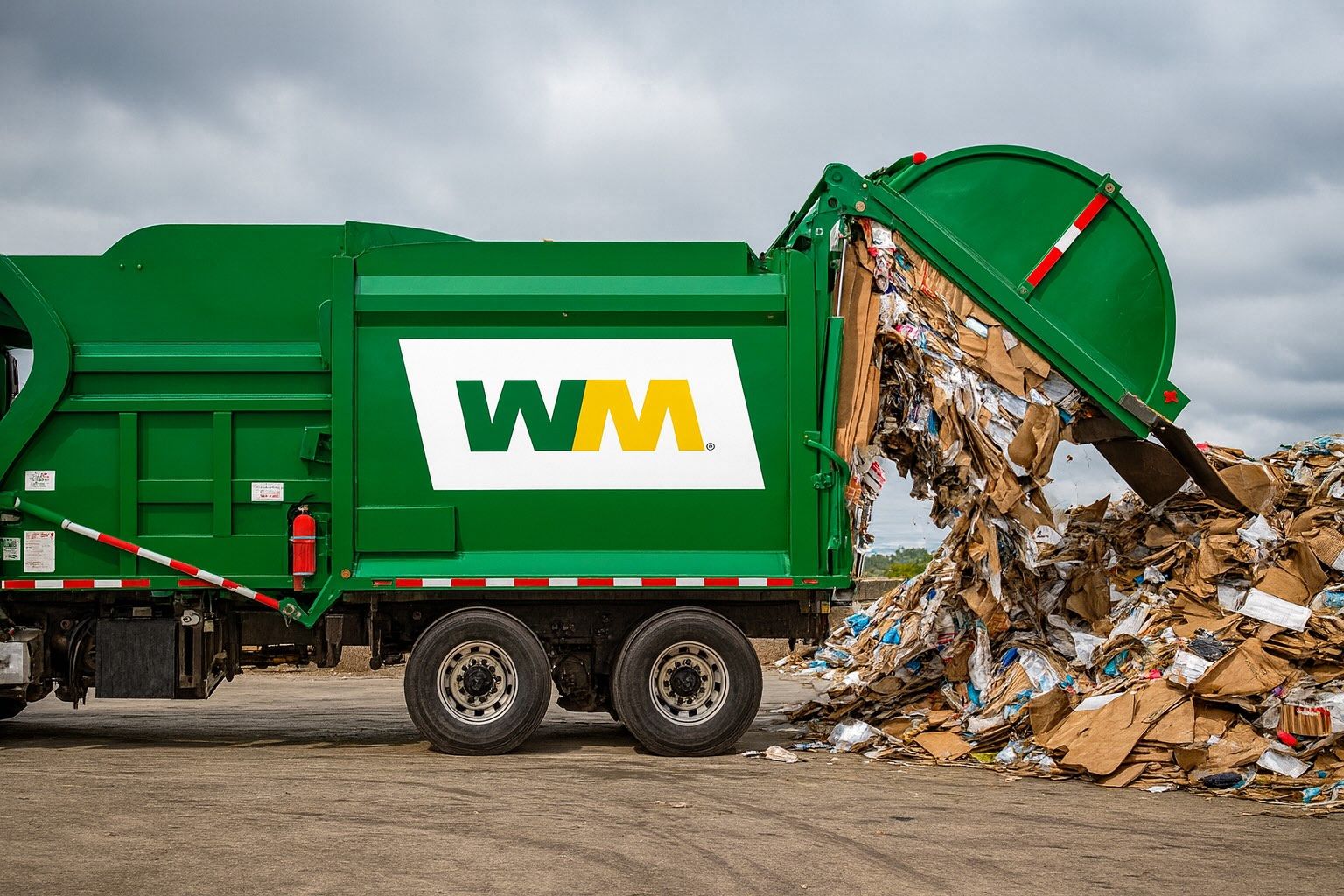- Steady Stock Performance: WM stock trades around $213–$214 per share after Monday’s close, roughly flat on the day [1]. Shares are up about 6% year-to-date, trailing the S&P 500’s ~15% gain [2] [3], and sit ~12% below their all-time high of $242.58 from June 2025 [4].
- Q3 Earnings Growth: Waste Management posted Q3 2025 revenue of $6.44 billion, up ~15% year-over-year, with adjusted EPS of $1.98 [5] [6]. Results were just shy of forecasts (FactSet consensus ~$6.50 B revenue, $2.02 EPS [7] [8]), but showed double-digit growth in operating cash flow [9]. Management reaffirmed full-year guidance for ~$7.5 B adjusted EBITDA and $2.8–$2.9 B free cash flow [10] [11], while trimming revenue outlook slightly to ~$25.3 B (vs ~$25.35 B expected) [12].
- Sustainability & Growth Initiatives: WM’s long-term strategy centers on high-margin sustainability projects and acquisitions. The company completed two new renewable natural gas (RNG) facilities and two recycling plants this quarter [13], expanding its renewable energy capacity. It also integrated the $7.2 billion Stericycle medical waste business (now WM Healthcare Solutions) this year [14], boosting its presence in healthcare waste disposal. These moves, alongside steady pricing gains, help WM generate “stable, rising cash flows” and support continued earnings and dividend growth [15] [16].
- Defensive Business Model: As North America’s largest waste services provider, WM enjoys durable demand and long-term contracts that make it a defensive, cash-generative stock. Over the past decade it delivered nearly 400% total return (~17% annually), outpacing the S&P 500 [17]. Investors value its resilience – waste services are needed in all economic climates – though commodity swings (recycling prices) and cost inflation can impact short-term results [18] [19].
- Analyst & Investor Outlook: Wall Street remains bullish on WM. ~24 analysts cover the stock with 15 Buys, 9 Holds, 1 Sell, and an average 12-month price target around $252 [20] – about 17–18% upside from current levels [21]. Recent target updates (e.g. UBS at $240, Barclays $271) reflect confidence in WM’s pricing power and cash flows even as some trimmed forecasts [22] [23]. The stock trades at ~29× forward earnings, slightly below industry averages [24], and offers a reliable $0.825 quarterly dividend (~1.5% annual yield) [25]. Analysts see WM as a “long-term staple” given its strong balance sheet, sustainability investments and commitment to shareholder returns [26].
Stock Performance and Recent Trends
Waste Management’s stock has been relatively steady in recent weeks, moving only modestly amid a volatile broader market. On October 27, WM shares closed around $213.77 (down just –0.4% for the day) ahead of its earnings release [27]. In after-hours trading following the results, the stock dipped roughly 2% to about $209 as investors digested the slight revenue miss and cautious guidance update. Overall, WM’s price has fallen about 0.8% over the past week and ~1.8% in the past month [28], a mild pullback largely in line with its sector.
Year-to-date, WM is up approximately 6–7% [29] – a respectable gain though lagging the S&P 500’s ~15%surge over the same period [30]. This underperformance in 2025 reflects the market’s rotation toward high-growth and technology names, while defensive stocks like WM have traded more sideways. Indeed, WM hit a record high of $242.58in June 2025 amid broad market strength [31], but has since eased back about 12%. Some of that decline came as interest rates rose and investors took profits in steady dividend payers. Even so, at current levels the stock is up roughly 2–3% from a year ago [32], demonstrating low volatility – WM’s beta is just 0.12 (far less volatile than the market) [33].
Notably, waste services stocks are often viewed as “recession-proof” or at least recession-resistant. Demand for trash collection and disposal remains stable in downturns, supporting WM’s earnings. Over the past month, WM shares only slipped ~2%, compared to a nearly +4% gain in the S&P, as investors favored riskier assets [34]. This gentle dip underscores WM’s defensive nature: it tends to lag in roaring bull markets but holds up better when the economy or market wavers. For example, the Business Services sector (which includes WM) gained just 0.95% last month while WM dipped –2.0%, reflecting some company-specific caution ahead of earnings [35]. Investors were clearly awaiting clarity on cost pressures and pricing – which the latest results have now provided.
Q3 Earnings: Solid Results with Slight Misses
On October 27, Waste Management reported its third-quarter 2025 earnings, showing healthy growth driven by acquisitions and pricing gains. Revenue jumped to $6.44 billion, a 14.9% increase over Q3 last year [36] [37]. This marks an acceleration in growth (full-year revenue is on pace for ~15% gain in 2025), thanks in part to the inclusion of WM’s new healthcare waste division and robust pricing. The company’s core Collection and Disposal unit achieved 6.0% higher core pricing and 3.8% yield (price increases on contracts) [38] [39], which helped offset inflation in costs.
On the earnings side, WM delivered adjusted net income of $801 million and adjusted EPS of $1.98 [40] [41], up slightly from $1.96 a year ago. This was essentially in line with analyst expectations (consensus ~$2.01), though the GAAP EPS of $1.49 was lower year-on-year due to one-time costs [42]. Those costs were related to integrating the big Stericycle acquisition and other adjustments. Importantly, cash flow from operations jumped by double digits [43], reflecting stronger profitability and working capital discipline. CEO Jim Fish highlighted “momentum in WM’s earnings growth and free cash flow conversion”, noting that the core trash collection business achieved record operating margins in Q3 [44]. Operating EBITDA margin in the collection/disposal segment hit 38.4% (adjusted) – an all-time high – thanks to technology upgrades and efficient route management [45].
While results were strong, there were a couple of soft spots. WM’s recycling and renewable energy units posted only modest growth as commodity prices for recycled materials remained low [46]. The average price for recycled commodities was about $68/ton in Q3, down from $101/ton a year ago [47], which weighed on revenue. Still, WM managed to grow adjusted EBITDA in those segments by focusing on cost cuts and higher-margin materials [48]. The newly acquired healthcare waste business (WM Healthcare Solutions) contributed roughly $628 million in Q3 revenue [49]. However, management noted that healthcare volumes were a bit lower than initially expected, one reason they slightly trimmed full-year revenue guidance [50] [51].
Guidance: Despite these minor headwinds, WM maintained a positive outlook. The company reaffirmed its 2025 adjusted EBITDA target of $7.48–$7.63 billion and free cash flow of $2.8–$2.9 billion [52] [53] – indicating solid 10%+ growth in both metrics for the full year. It did revise 2025 revenue guidance to approximately $25.28 billion (the low end of prior range) due to the recycling price slump and a “modestly lower” healthcare contribution [54] [55]. Notably, even at $25.3 B, revenue would be ~15% higher than 2024 – a robust clip for a mature industry. WM also boosted its expected profit margins, now seeing adjusted EBITDA margins of 29.6%–30.2% for 2025 (ticking up from prior ~29.6% midpoint) [56]. This suggests cost controls and pricing will preserve profitability.
In the earnings release, CEO Fish sounded confident, stating “strong results across all aspects of our business reinforce our confidence in achieving full-year guidance as well as our long-term financial objectives” [57]. He emphasized that 86% of WM’s revenue base is tied to contracts with pricing adjustments, which helps insulate margins even when costs rise. With inflationary pressures like higher driver wages and fuel costs, WM’s ability to continue pushing through price increases (without losing customers) is a key to its success. So far in 2025, that pricing power appears intact – an encouraging sign for investors.
Sustainability Projects and Growth Drivers
A centerpiece of Waste Management’s story is its push into sustainability and new growth verticals, which the company believes will drive future gains. WM has been transforming “trash into cash” not just through raising prices, but by investing heavily in recycling, renewable energy, and specialized waste services. In fact, over the past few years WM allocated about $3 billion to upgrade recycling facilities and develop renewable natural gas (RNG) projects at its landfills [58]. These investments are starting to bear fruit. In Q3, WM celebrated the completion of two major RNG facilities – plants that capture landfill methane and convert it to pipeline-quality gas [59]. RNG is sold as a clean fuel (often for transit fleets), and demand is rising as businesses seek low-carbon energy. Similarly, WM brought two new recycling facilities online, expanding capacity to process plastics, paper and other materials. Although commodity prices are currently low, these modern facilities are more automated and efficient, positioning WM to profit when recycling prices recover.
Another growth driver has been strategic acquisitions. Most notable is WM’s purchase of Stericycle’s environmental health business for $7.2 billion, completed earlier in 2025 [60]. This deal instantly made WM a big player in medical and hazardous waste disposal – a profitable niche given the stringent regulations and steady volumes from hospitals and labs. Now branded WM Healthcare Solutions, the segment contributed over 9% of company revenue in Q3 [61]. While initial revenue is slightly below forecast, WM is confident in cross-selling opportunities (e.g. offering regular trash clients additional medical waste services). The integration is ongoing, but management noted “we continued to advance the integration of WM Healthcare Solutions, enhancing the breadth of services we offer” [62]. Long-term, healthcare waste is expected to be a growth market and less cyclical than traditional trash pickup.
Beyond these, WM provides other value-added services like landfill gas-to-electricity plants, composting/organics processing, and even consulting on sustainability for corporate clients. Such services not only generate revenue, they deepen customer relationships (a company handling a client’s recycling, hazardous waste and consulting is less likely to be replaced by a competitor just for slightly lower price on trash pickup). This integrated model has turned WM into what TS2.tech called “a high-margin, durable business” with diverse revenue streams [63]. In 2024, WM’s total revenue was about $22 billion with nearly $3 billion in profit [64]. By 2025, revenue is tracking above $25 billion – partially from acquisitions, but also organic growth in its base business.
Crucially, WM’s size and scale give it an advantage in efficiency. It operates the largest network of landfills in North America and a collection fleet of over 20,000 trucks. With that scale, WM can spread fixed costs and invest in technology (like route optimization software and natural gas-fueled trucks) that smaller rivals cannot. This has translated into superior margins and strong free cash flow generation. Free cash flow is what funds dividends, share buybacks, and further investments – and WM expects to produce nearly $2.9 billion of FCF this year [65] [66], a double-digit increase. Some of that cash is going back into ESG (environmental, social, governance) initiatives – for example, WM has one of the largest heavy-duty natural gas truck fleets in the industry and is aggressively cutting its carbon footprint [67]. These steps not only appease regulators and eco-minded investors, they often save costs (cheaper fuel, etc.) and open up new revenue like carbon credits.
From an investor perspective, WM’s commitment to sustainability serves a dual purpose: it aligns with growing ESG investment trends (making the stock attractive to funds with sustainability mandates), and it creates tangible new profit centers (RNG, recycled commodities, renewable power). The company’s strategy of tying customer contracts to inflation indices and recycling price adjustments also helps mitigate risk [68]. If inflation stays high, WM can pass through higher costs to municipal clients. If oil or commodity prices swing, many contracts allow periodic fee adjustments. This flexibility helped WM maintain its dividend resilience and even grow its payout consistently over the years [69].
Speaking of dividends, Waste Management has been a reliable income stock. The company currently pays $0.825 per share quarterly [70] (recently paid in September), which equates to a $3.30 annual dividend. At the current share price, that’s about a 1.5% yield. WM has raised its dividend every year for over a decade, typically by mid to high single-digit percentages annually. Additionally, WM executes share buybacks (it repurchased ~$500 million of stock in the first half of 2025, for example) as part of returning cash to shareholders. With its healthy balance sheet and stable cash flows, investors can likely count on continued dividend growth even as the company invests in new projects. In short, WM is balancing growth and shareholder returns – using “trash” to fuel both innovation and steady income for its owners.
Analyst Views and Stock Forecast
Waste Management’s stable outlook and consistent execution have earned it generally favorable reviews on Wall Street. According to Bloomberg and TS2 data, the consensus rating on WM is a “Buy”, with roughly 60% of analystsrecommending Buy or Overweight and the rest on Hold (only a lone analyst rates it a Sell) [71] [72]. The average 12-month price target is about $250–$253 per share [73] [74]. That implies ~17–18% upside from the current ~$214 price – suggesting analysts see room for the stock to climb as it digests recent investments and continues to grow earnings. Price targets range from a low of ~$225 up to a Street-high of $277 [75] [76]. Notably, J.P. Morgan recently projected the high-end $277 target, citing WM’s pricing power and the potential for upside if recycling markets recover [77]. On the low end, a more cautious $225 target reflects concerns that the stock’s valuation (near 30× earnings) already discounts a lot of good news.
Several analysts adjusted their models in October following peer earnings and macro updates. For instance, UBS trimmed its target to $240 (from $265) while maintaining a Neutral view [78] [79], and Morgan Stanley cut its target to $232 with an Equal-Weight rating [80]. These tweaks were largely due to higher interest rates (which can pressure valuations of dividend stocks) and near-term recycling weakness. However, other firms remain upbeat: Barclays has an Overweight/Buy with a $271 target [81], and Oppenheimer recently reiterated an Outperform with a $262 target [82]. Even the more conservative analysts acknowledge WM’s strengths – “robust free cash flow and defensive growth profile,” as one research note put it – but some prefer to wait for a slightly lower price to get more margin of safety.
From a valuation perspective, WM trades at about 29× forward earnings and EV/EBITDA near 13×, which is on par with other large-cap industrial services companies [83]. Its PEG ratio (price/earnings-to-growth) around 2.7 is a bit higher than the industry average ~2.5 [84], reflecting WM’s premium status and steadier growth. In plain terms, the stock is not cheap, but investors have historically been willing to pay up for WM’s reliability. By comparison, the broader market S&P 500 trades around 18× forward earnings, but with far more cyclicality. WM’s sector (Waste Removal Services) ranks in the middle of the pack – Zacks Investment Research gives it an industry rank of 159 out of 250, indicating average prospects near term [85]. That said, WM’s individual Zacks Rank is #3 (Hold), as recent earnings estimate revisions have been minimal [86] [87]. If commodity prices or volumes surprise to the upside in coming quarters, we could see upward estimate revisions that might boost that rank.
Analysts also point out WM’s shareholder-friendly capital allocation. The stock’s dividend yield (~1.5%) is modest, but very secure – the payout consumes less than half of annual free cash flow. In 2025, WM is on track for ~$2.85 B in free cash, while dividends will total about $1.1 B [88] [89]. This leaves ample room for buybacks (WM has repurchased shares consistently) and debt reduction or bolt-on deals. Credit ratings for WM are strong (investment grade), so financing growth is not an issue. “Waste Management’s fortress balance sheet and recurring cash streams support its dividend resilience,” notes TS2.tech, which called WM “a potential long-term staple for portfolios”due to these qualities [90]. Indeed, many institutional investors hold WM as a core defensive position – a stock that may not double overnight but can deliver high-single-digit annual returns (5–10% stock gains + ~1–2% yield) with lower risk than most equities. In an uncertain economy, that profile is attractive.
Investor Sentiment and Outlook
Overall investor sentiment on WM remains positive, leaning on the company’s decades-long track record of steady growth. Waste Management has arguably “seen it all” – from economic recessions to commodity booms – and navigated each with consistent profitability. As one fund manager quipped, “Trash collection isn’t going out of style. It’s the ultimate basic service”. The essential nature of WM’s business, coupled with its innovative push into greener technologies, gives investors confidence in the long-term trajectory. Even in the face of short-term challenges like rising labor costs or fluctuating recycling prices, WM has tools to manage through (pricing adjustments, cost cuts, diversification).
That said, shareholders are keeping an eye on a few key risks. First, cost inflation: driver shortages and higher wages, plus fuel costs, could pressure margins if not offset. So far WM has maintained a positive price-cost spread (raising prices more than costs) [91], but this requires continued discipline. Second, regulatory changes: aggressive environmental regulations or recycling mandates could require new investments – although WM also stands to benefitfrom policies favoring renewable energy or higher landfill standards that raise barriers to entry. Third, competition and M&A: the waste industry has consolidated with major players like Republic Services (RSG) and Waste Connections (WCN). Any big merger or price war in local markets could impact WM, though the industry has been rational on pricing in recent years.
On the upside, many investors see WM as a relatively safe haven if economic growth slows. Its services are mostly subscription-like and under multi-year contracts, providing visibility. The company’s Q3 performance – delivering double-digit cash flow growth despite inflation and mixed economic signals – underscores that resilience [92]. Management even hinted that 2026 could be a banner year for free cash flow, projecting nearly $3.8 B in FCF next year if trends hold [93] [94]. That would likely mean another healthy dividend increase and capacity for strategic investments.
For now, Waste Management, Inc. stock appears to offer a balanced proposition: modest growth, reliable income, and a sustainability angle that provides optionality for future expansion. Its current stock price in the low $210s leaves room for upside if the company hits its targets and the market rewards its consistency. Most analysts expect high single-digit percentage stock gains over the next year – not a dramatic jump, but in line with WM’s historical pattern of steady appreciation [95] [96]. Combined with the dividend, that could deliver a low double-digit total return, an attractive outcome for a defensive holding.
In summary, Waste Management is turning trash into treasure for shareholders gradually. The latest earnings show that even with a few bumps (like lower recycling prices), WM’s core business is humming with record margins [97] and strong cash generation. The expansion into renewable energy and medical waste provides new avenues for growth, while the legacy landfill and collection operations continue as cash cows. For investors seeking stability in uncertain times, WM stock offers a unique mix of durability and incremental growth. As the company likes to remind stakeholders, “WM is built for the long run” – and for many portfolios, that’s pure gold in a world of uncertainty.
Sources: Waste Management investor releases and earnings report [98] [99]; TS2.tech market analysis [100] [101]; TradingView financial data [102] [103]; Zacks Equity Research [104] [105]; MarketBeat/MarketScreener analyst insights [106] [107]; Business Wire and company statements [108] [109].
References
1. stockanalysis.com, 2. ts2.tech, 3. tickernerd.com, 4. www.tradingview.com, 5. www.tradingview.com, 6. www.tradingview.com, 7. www.tradingview.com, 8. www.tradingview.com, 9. www.businesswire.com, 10. www.businesswire.com, 11. www.businesswire.com, 12. www.marketscreener.com, 13. www.businesswire.com, 14. ts2.tech, 15. ts2.tech, 16. ts2.tech, 17. ts2.tech, 18. www.marketbeat.com, 19. www.webull.com, 20. tickernerd.com, 21. stockanalysis.com, 22. tickernerd.com, 23. tickernerd.com, 24. www.nasdaq.com, 25. www.businesswire.com, 26. ts2.tech, 27. stockanalysis.com, 28. www.tradingview.com, 29. tickernerd.com, 30. ts2.tech, 31. www.tradingview.com, 32. www.tradingview.com, 33. www.tradingview.com, 34. www.nasdaq.com, 35. www.nasdaq.com, 36. www.businesswire.com, 37. www.businesswire.com, 38. www.businesswire.com, 39. www.businesswire.com, 40. www.businesswire.com, 41. www.businesswire.com, 42. www.businesswire.com, 43. www.businesswire.com, 44. www.businesswire.com, 45. www.businesswire.com, 46. www.businesswire.com, 47. www.businesswire.com, 48. www.businesswire.com, 49. www.businesswire.com, 50. www.businesswire.com, 51. www.businesswire.com, 52. www.businesswire.com, 53. www.businesswire.com, 54. www.businesswire.com, 55. www.marketscreener.com, 56. www.businesswire.com, 57. www.businesswire.com, 58. ts2.tech, 59. www.businesswire.com, 60. ts2.tech, 61. www.businesswire.com, 62. www.businesswire.com, 63. ts2.tech, 64. ts2.tech, 65. www.businesswire.com, 66. www.businesswire.com, 67. www.businesswire.com, 68. ts2.tech, 69. ts2.tech, 70. www.businesswire.com, 71. tickernerd.com, 72. tickernerd.com, 73. stockanalysis.com, 74. tickernerd.com, 75. stockanalysis.com, 76. tickernerd.com, 77. tickernerd.com, 78. www.marketscreener.com, 79. tickernerd.com, 80. www.marketscreener.com, 81. tickernerd.com, 82. tickernerd.com, 83. www.nasdaq.com, 84. www.nasdaq.com, 85. www.nasdaq.com, 86. www.nasdaq.com, 87. www.nasdaq.com, 88. www.businesswire.com, 89. www.businesswire.com, 90. ts2.tech, 91. www.businesswire.com, 92. www.businesswire.com, 93. www.businesswire.com, 94. www.businesswire.com, 95. ts2.tech, 96. tickernerd.com, 97. www.businesswire.com, 98. www.businesswire.com, 99. www.businesswire.com, 100. ts2.tech, 101. ts2.tech, 102. www.tradingview.com, 103. www.tradingview.com, 104. www.nasdaq.com, 105. www.nasdaq.com, 106. www.marketscreener.com, 107. tickernerd.com, 108. www.businesswire.com, 109. www.businesswire.com





